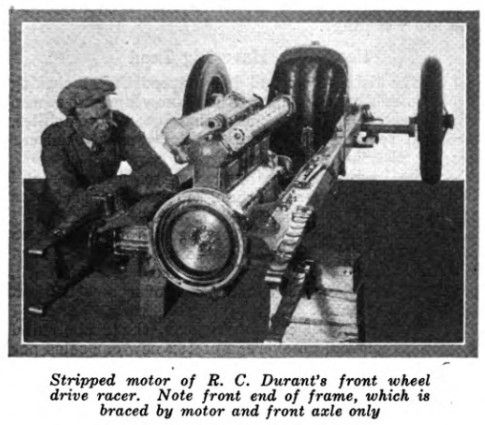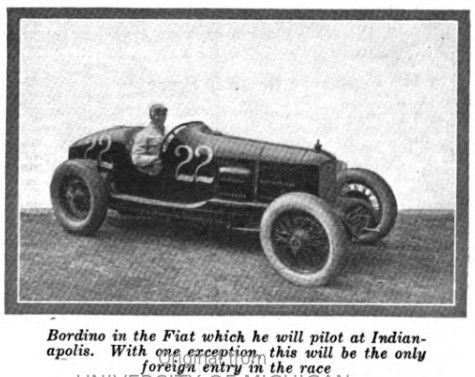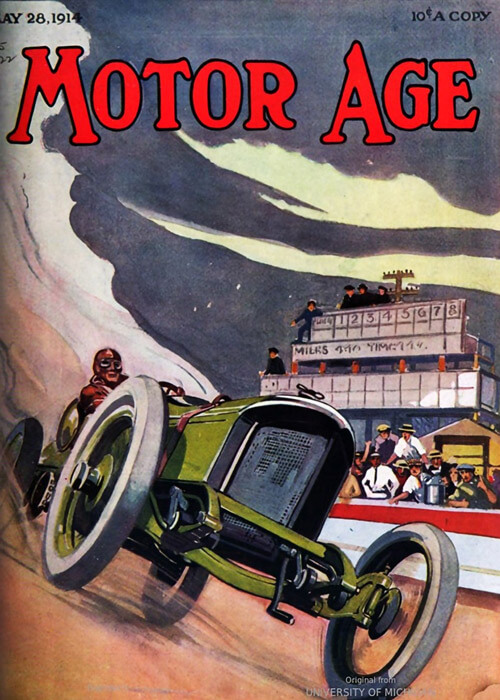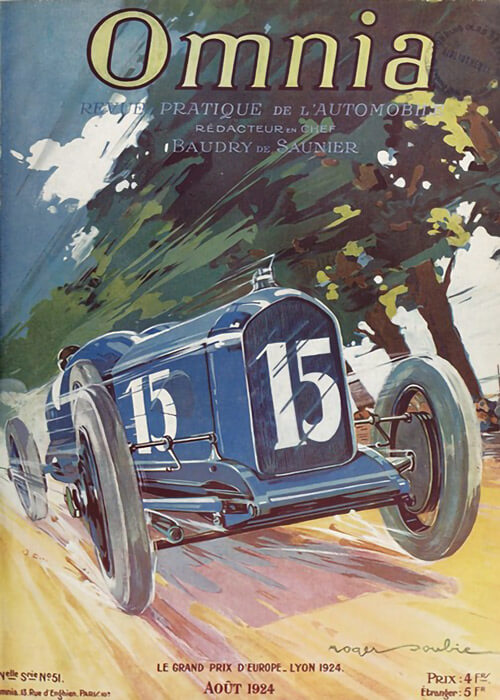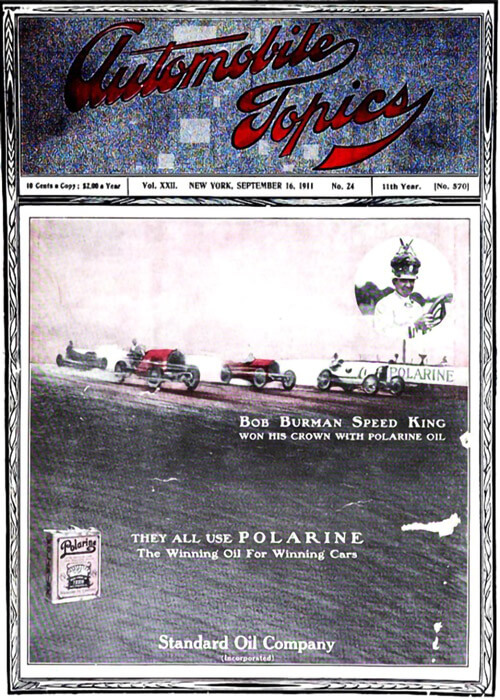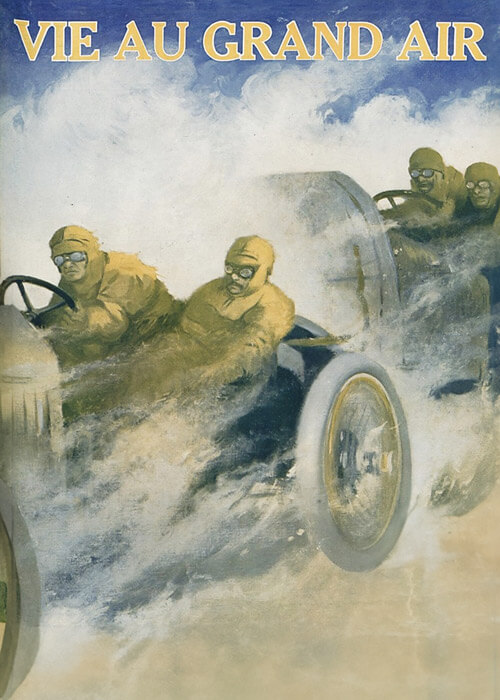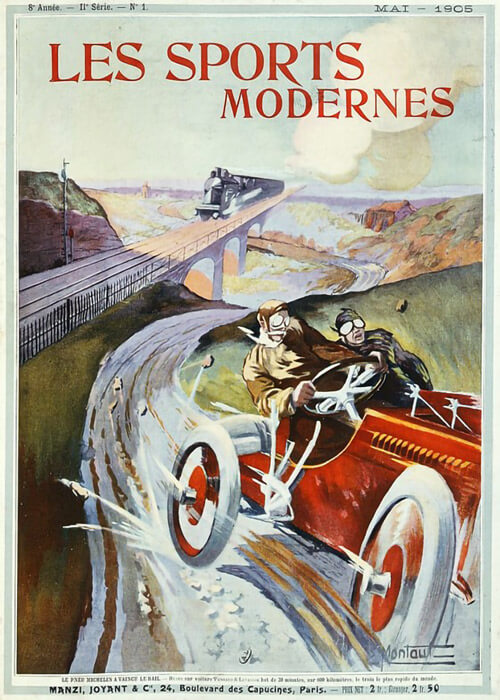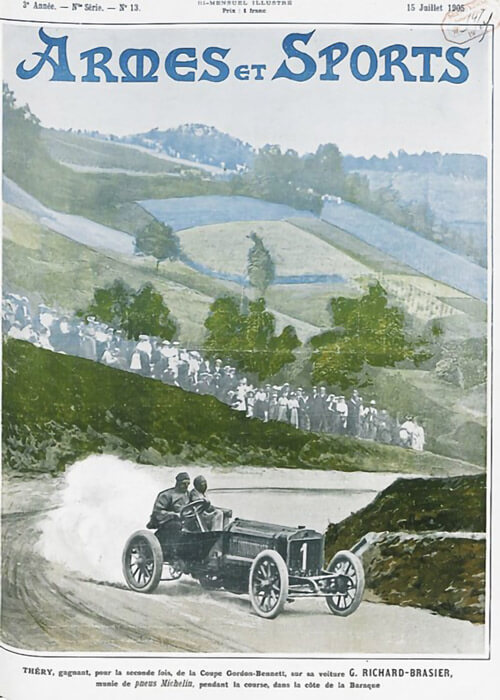

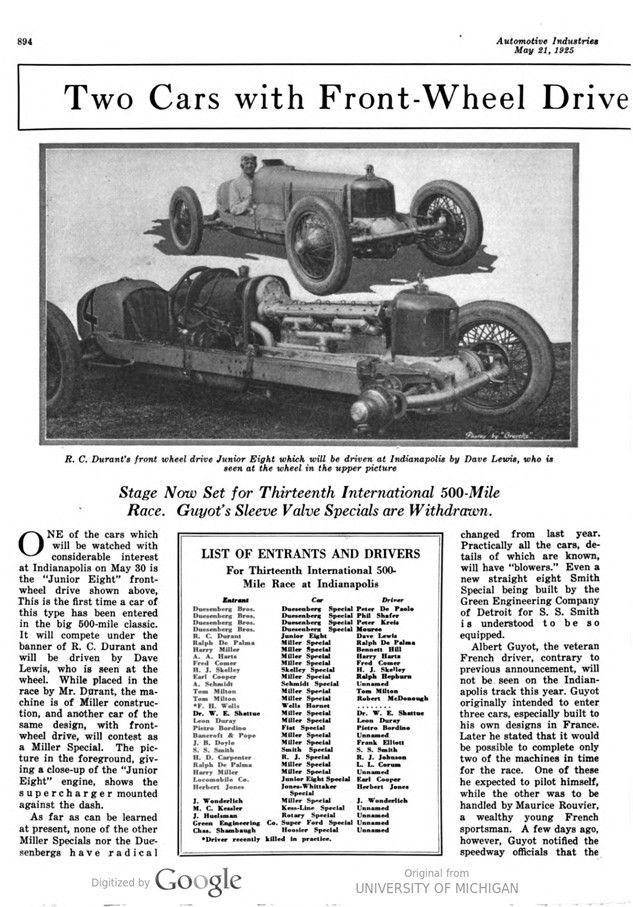

Text and jpegs by courtesy of hathitrust.org www.hathitrust.org, compiled by motorracinghistory.com
Automotive Industries Vol. 52, No. **, May 21, 1925
Two Cars with Front-Wheel Drive Among the Entries at Indianapolis
Stage Now Set for Thirteenth International 500-Mile Race.
Guyot’s Sleeve Valve Specials are Withdrawn.
ONE of the cars which will be watched with considerable interest at Indianapolis on May 30 is the “Junior Eight“ front-wheel drive shown above. This is the first time a car of this type has been entered in the big 500-mile classic. It will compete under the banner of R. C. Durant and will be driven by Dave Lewis, who is seen at the wheel. While placed in the race by Mr. Durant, the machine is of Miller construction, and another car of the same design, with front-wheel drive, will contest as a Miller Special. The picture in the foreground, giving a close-up of the „Junior Eight“ engine, shows the supercharger mounted against the dash.
As far as can be learned at present, none of the other Miller Specials nor the Duesenbergs have radical changed from last year. Practically all the cars, details of which are known, will have „blowers.“ Even a new straight eight Smith Special being built by the Green Engineering Company of Detroit for S. S. Smith is understood to be so equipped.
Albert Guyot, the veteran French driver, contrary to previous announcement, will not be seen on the Indianapolis track this year. Guyot originally intended to enter three cars, especially built to his own designs in France. Later he stated that it would be possible to complete only two of the machines in time for the race. One of these he expected to pilot himself, while the other was to be handled by Maurice Rouvier, a wealthy young French sportsman. A few days ago, however, Guyot notified the speedway officials that the work of constructing the cars had been delayed and that he would be compelled to withdraw his entries entirely.
The withdrawal came as somewhat of a disappointment for the racing enthusiasts, as the Guyot cars were to employ motors of the single sleeve type and their performance would have been watched with more than usual interest on that account.
The only foreigners left in the race since Guyot’s withdrawal are Pietro Bordino, who is already on the scene with his Bordino Fiat, and Albert Schmidt, of whose Schmidt Special nothing very definite is yet known beyond the fact that it is of French construction. The make and type are still mysteries.
Most of the drivers entered in the race are now on the bricks of the 2½ mile oval. The cars which took part in the Charlotte, N. C., contest have reached Indianapolis with their drivers, among whom are Cooper, Hartz and Milton, who won first, second and third, respectively, in the 250-mile run at Charlotte on May 11.
As in last year’s race, the race this year is limited to cars with engines having a piston displacement of not over 122 cu. in. Whether or not the winning car this year will better the record made by Joe Boyer’s Duesenberg last year is a much-mooted question in racing circles. It is pretty much a question of supercharging, and since a lot of development work has been going on along this line since last year’s record-smashing event, it is almost a safe bet to say this year the winning car will equal, if indeed not surpass, last year’s mark.
Among the drivers who are entered to pilot mounts, the Miller Specials have some of the best-known names: Tommy Milton, Earl Cooper, Ralph De Palma, Bennet Hill, Harry Hartz, Frank Eliott and McDonough appear in the early driver lists for the Millers, while Peter De Paolo, Phil Shafer and Peter Kreis are down to pilot three of the Duesenbergs entered by the Duesenberg Brothers, with the fourth pilot to be nominated later.
Subscriptions for the Citizens Lap Prize Fund, $20,000 added purse for drivers in the race, are pouring in rapidly.
The purse is divided into 200 prizes—$100 for the driver crossing the tape first in each of the 200 tours of the course.
It makes a race within a race, dividing competitors into two divisions—the “beat it” boys who go out for the lap prize at a furious pace, hoping to go on through the race, and the „conservatives,“ who shun the lap money and plan on the lion’s share of the $50,000 speedway purse by winning the race.
Total prizes will approximate $100,000.
Tickets for the Silver Anniversary and Welcoming Dinner to automotive men which is to be given the night be- fore the race at the Indianapolis Athletic Club by the Indiana Section of the Society of Automotive Engineers went on sale week before last. Out-of-town men who desire to attend can make reservations through George Briggs, chairman, in care of Wheeler Schebler Carbureter Co., Indianapolis. More than half of the capacity of the big main dining room of the club is taken by Indianapolis automotive organizations for their staffs and distributors who will attend the race. Among the speakers at the dinner will be Major Gen. Mason M. Patrick of the U. S. Air Service, C. F. Kettering, president of the General Motors Research Corp., and Charles M. Schwab.
Photo captions.
R. C. Durant’s front wheel drive Junior Eight which will be driven at Indianapolis by Dave Lewis, who is seen at the wheel in the upper picture. Photos by „Gravela“
Stripped motor of R. C. Durant’s front wheel drive racer. Note front end of frame, which is braced by motor and front axle only.
Charles Shambaugh, engineer from Lafayette, Ind., at the wheel of his Hoosier Special, a 4-cylinder, chain drive car of his own creation which will be seen in the race.
Bordino in the Fiat which he will pilot at Indianapolis. With one exception, this will be the only foreign entry in the race.

